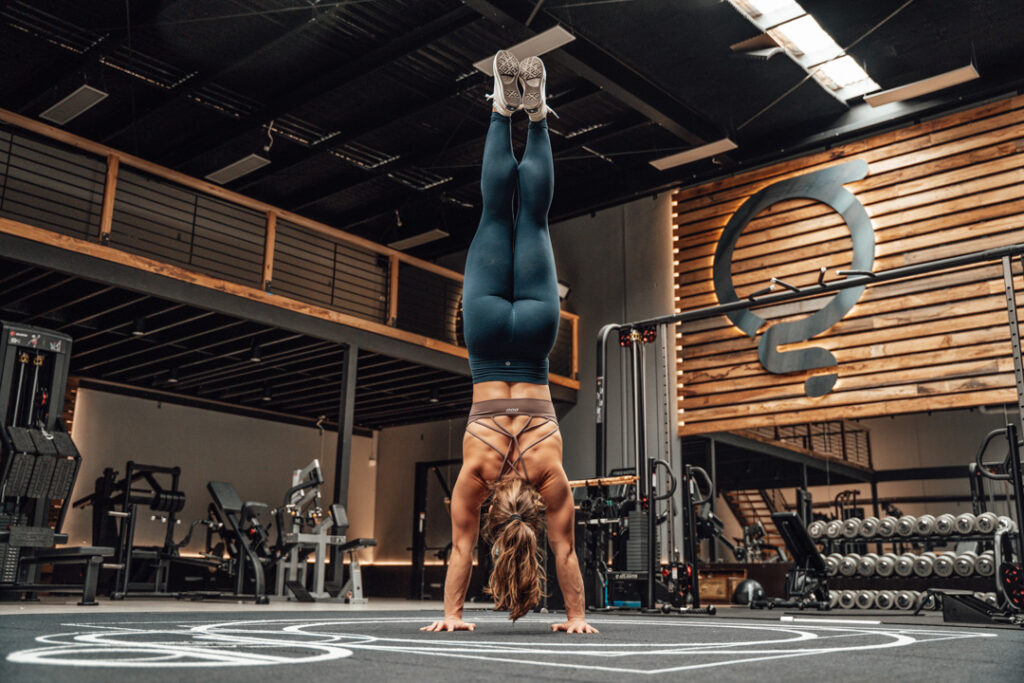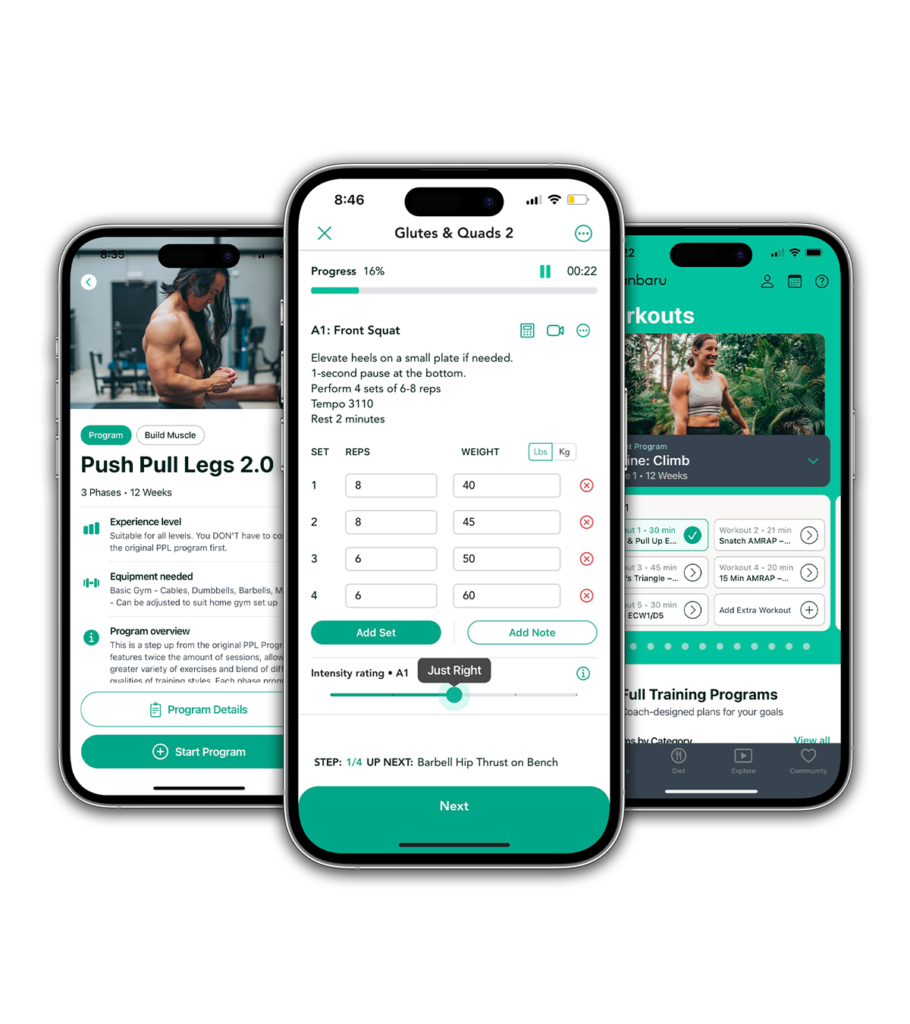
The “stack” is a handstand concept that involves your head, shoulders, ribs, hips, knees and toes all being in a straight line from top to bottom.
Lots of us chase improvements in the stack as a desirable handstand shape. It allows us to explore other handstand movements and is therefore often considered the gold standard for basic handstand shapes.
Getting good at the stack requires an understanding of how the head, ribcage, and pelvis influence each others’ positions, as well as strength and mobility to create space through the shoulders.
The following drills aim to help you understand your stacked position by promoting alignment of the head, pelvis, and ribcage. It will also help teach you to push into the floor and find the right amount of tension.
COGS
What is it?
A simple explainer drill on the floor to help you understand how the head, pelvis and ribcage influence each others’ shapes and positions.
Technique
Lying flat on the floor with your knees bent and feet flat, aggressively tip your pelvis forward in a way that arches your back. Feel how your ribcage pops up and open, and how your chin tucks to accommodate the movement against the skull. Pull the pelvis in the opposite direction and exhale fully like you’re blowing up a balloon. Notice how the ribs are now flush with the abs, and the head has tilted back up to neutral or slightly extended.
This exact movement also happens in a handstand. It’s why it’s important not to overreach the head, or extend the spine if you’re aiming for a stacked handstand. We can gently pull the ribs down and keep the head just slightly tilted up without affecting the whole system, but jutting the head out or flaring the ribs substantially will impact the rest of the body line.
Common Mistakes
Forcing the issue – this movement should be able to work with fairly gentle nudges in either direction.
Box pike shrug
Why?
This movement helps understand and encourage an “active shoulder,” or the intentional push into the floor that elevates the shoulder blades in a handstand to create more space and a more open shoulder angle.
How
Climb your way into a pike on a box, either with straight or slightly bent legs. Press hard into the floor to elevate the shoulder blades as hard as you can (imagine you’re shooting your bum up to the sky higher than it is now). Then, sink down into the shoulder blades so your whole body moves toward the floor. Repeat.
Keep this active shoulder position in your handstand holds and walks!
90 Degree “Yoga” Handstand Hold
What is it?
A drill that helps you figure out how it feels to be in the stacked position in a handstand.
Technique
Bow at the hip with a straight back until your torso is parallel to the floor. It’s okay if you have to bend your knees to allow that. Reach your hands to the wall and walk in until your hands and feet are firmly planted – hands on the wall, feet on the floor – with your hip bent at a 90 degree angle. If you looked from the side, it should be as if you’ve drawn a square with your torso, legs, floor, and wall.
Now, switch the hands and feet. Put your feet on the wall where the hands were, and walk your hands in to wherever your feet were previously. It might feel a lot more cramped or even scary than you expected – but your hips should be right over the shoulders and hands.
45 Degree Handstand Hold on Wall
What is it?
A position that forces you to fight gravity to find the desired shape.
Technique
Walk your feet partially up the wall into a wall-facing handstand, or halfway up a wall walk if that’s familiar to you. In this position, pull your mid and low back toward the ceiling while pushing into the floor like in your pike shrug. Your body should be long, and your ribs should be tucked away with no sag in the lower back.
You may have to shift your feet slightly further up the wall if this has created more length in your body. Hold this position, it may feel a little burny in your abs and shoulder muscles.
45 Degree Lateral Handstand Walk
What is it?
Exactly like the above, but with the added challenge of having to work against movement by walking side to side.
Technique
From your 45-degree handstand position, step your hands and feet to one side for a few steps. Then do the same reverse. Don’t let your lower back sag or let your hips wobble excessively as you step. Keep both hips facing the floor as much as you can.
45 Degree to Full Handstand Hold on Wall
What is it?
A drill to help solidify the technique and position of the 45-degree handstand and carry over all the important pieces into a vertical handstand on the wall.
Technique
From your 45-degree position, step the hands in toward the wall until you’re in a wall-facing handstand. Walk back down to your 45-degree position and check whether you’ve lost any of the pieces you needed to keep (ribs flat to abs, long body, and pressure into the floor). Walk back up and repeat for reps.

Ready to workout?
Follow proven programs written by expert coaches, delivered in an easy-to-use app built by lifters, for lifters.
Related Posts
How Ganbaru Method helps women in their fifties stay fit
It’s never too late for aging women to start their fitness journey. At 58, Iris is a personal trainer at a women-only gym, an active lifter, and a dancer.
View more How Ganbaru Method helps women in their fifties stay fit
How Ganbaru Method helped Anna transform her body & life
Anna, 30, is a tech sales professional who changed her physique by gaining muscle and losing fat with Ganbaru Method.
View more How Ganbaru Method helped Anna transform her body & life
This Ganbaru CrossFit program got a new dad back in the best shape of his life
Petr, 34, is an executive chef, husband, and father of a toddler. This is how he got his fitness back on track.
View more This Ganbaru CrossFit program got a new dad back in the best shape of his life


